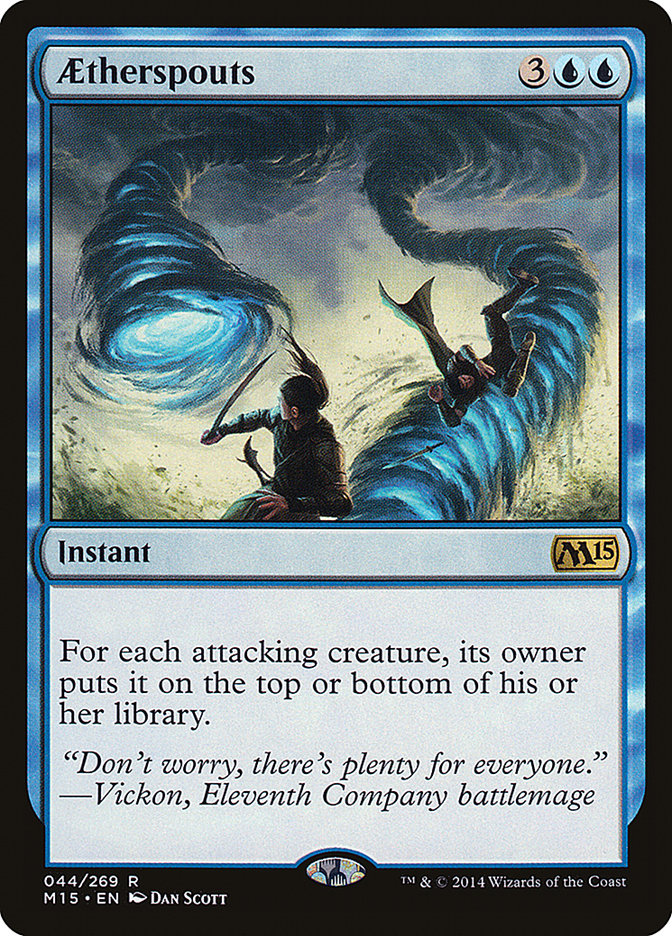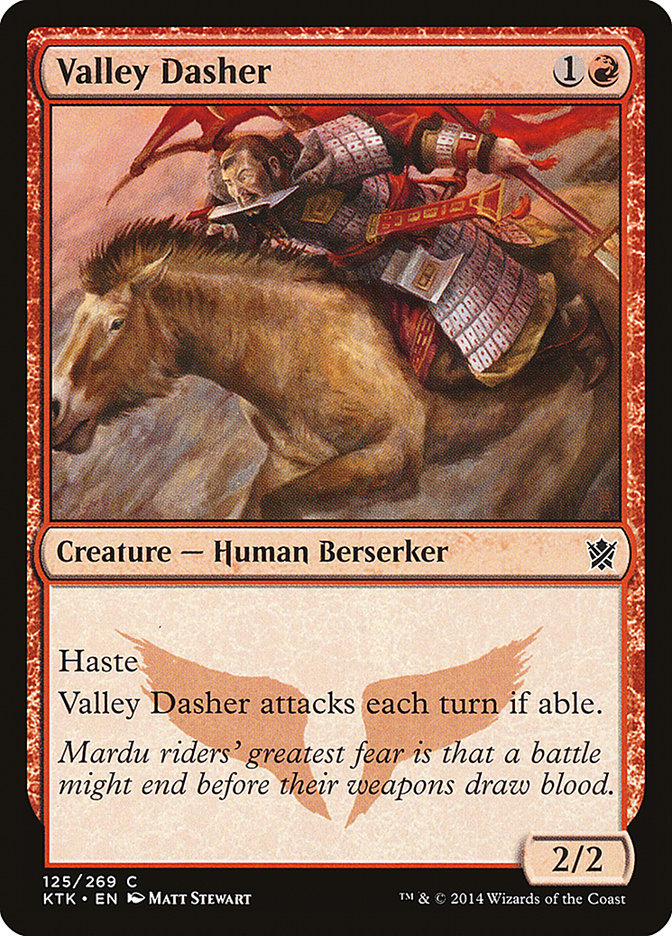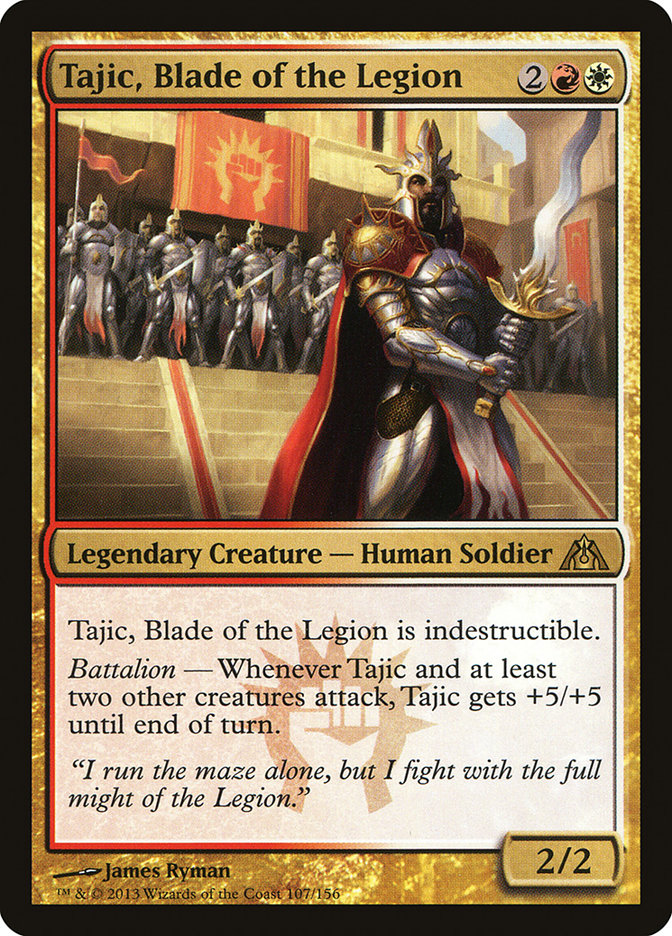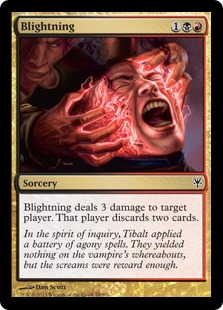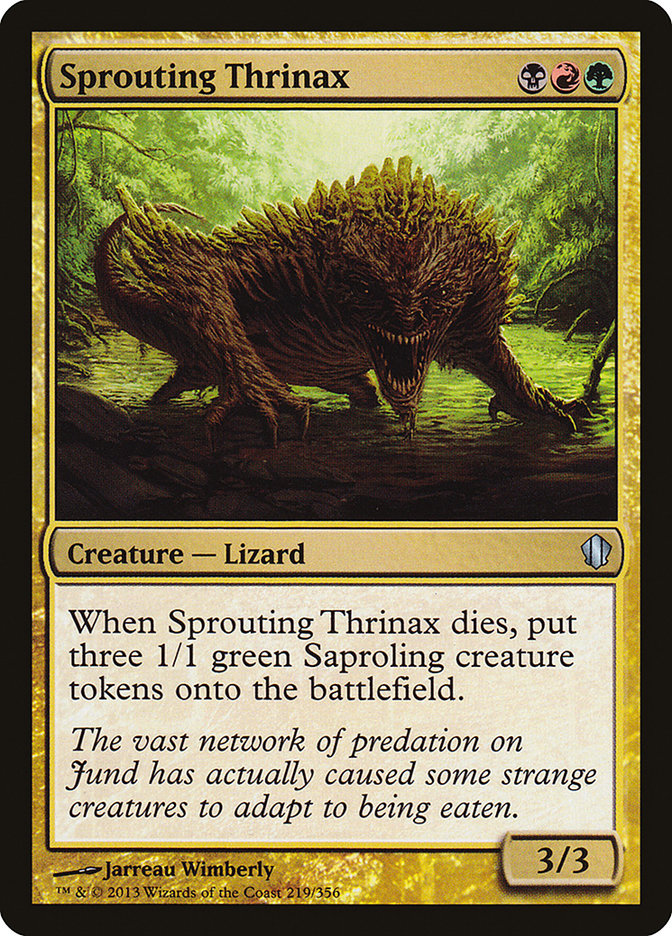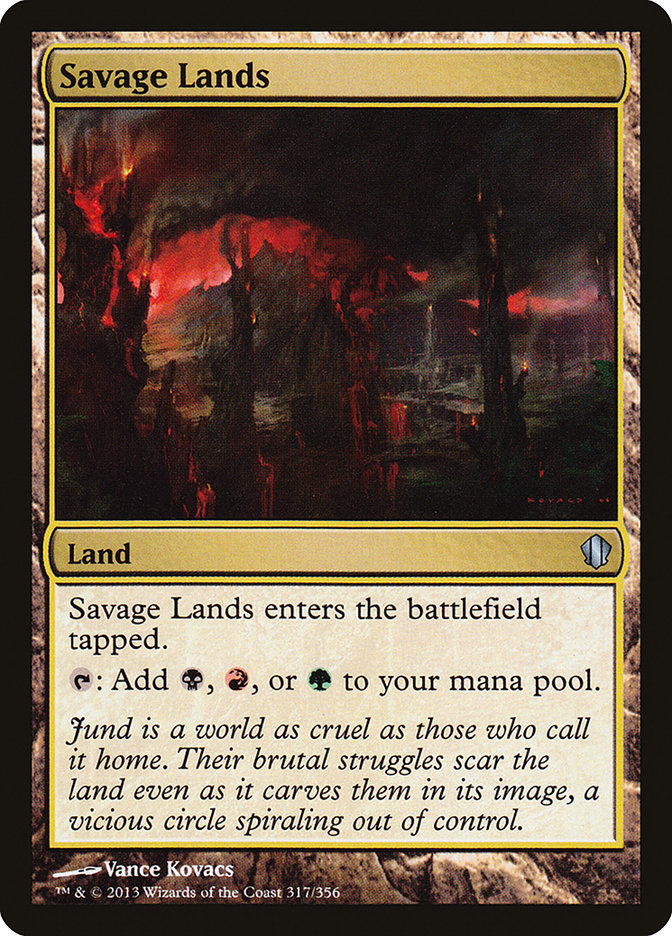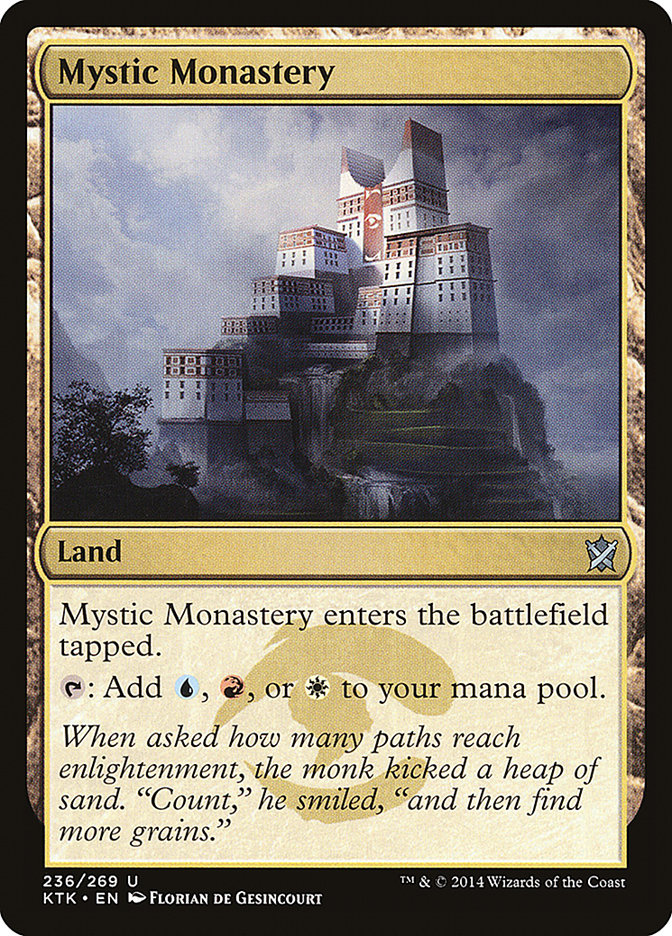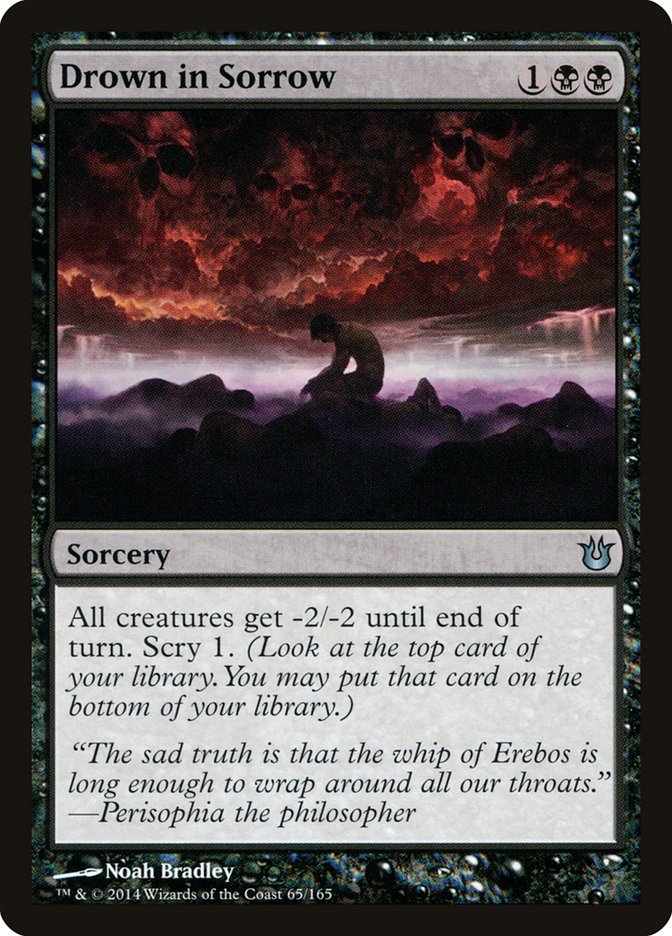One of the worst things that you can do in tournament Magic is be embarrassed.
Whether it is in Limited or Constructed, the wins you are going for don’t care about how silly a card looks, they care about what works. That attitude is
what you should take as well.
There are an infinite variety of examples I’ve seen over the years. Most recently, for example, both Andrew Cuneo (and The Pantheon), and I independently
played this card in our U/B Control deck at Pro Tour Khans of Tarkir:
Since that event, Owen Turtenwald has cut the single copy of the card from the Pantheon 75, and I’ve gone down to a single copy, but if the metagame
shifted, I’d be back up to two in a heartbeat.
The same question is true in Limited. Recently in a practice Team Sealed event (GP Nashville is this
weekend, so tonight would be the last chance to register), we had a bizarre R/G Aggro deck for one of our builds. It had several great two-drops,
but it just wasn’t winning. However, when we put in this:
Suddenly, having just a little more in that part of the deck, it started performing. It didn’t matter that the previous build had had what we
thought were plenty of two-drops. The deck itself just needed more to do early, and Valley Dasher, despite often being a card that is going to die very
quickly when it hits play, served that role.
Last year, I played in a $5k event, winning it with these two cards in my sideboard:
Chandra’s Outrage was in my sideboard of my version of the R/W Midrange Aggro deck I was playing constantly (at least until I switched back to U/W
Control). I didn’t play it because I thought the card was good. I played it because I needed another card to fight Blood Baron of Vizkopa.
In the much further past, I’d even used Chandra’s Outrage in Extended (when that was still a format), in the sideboard of a Mono-Red Aggro list that just
needed to be able to consistently deal four damage to a creature. I’d already exhausted my four Flame Javelin, and Burst Lightning, while present in my
deck, didn’t solve the problem as well if it was going to cost me five mana. Chandra’s Outrage not only did that, but it had an upside!
Leading into PTM15, I was definitely pumped about Stoke the Flames. In that $5K event, I’d not only run Chandra’s Outrage in the board, but I’d run Mizzium
Mortars main. When you are an aggessive red deck, and you are choosing to play a removal spell that doesn’t have the ability to go to the face, you have to
ask yourself if it is correct. At the time, it was, but that was basically because you had so very few options that could pull off the job that Mortars
did. With Stoke in my head, I started working on Burn immediately, placing it as slightly behind U/W Control in my recommendations to Matt Sperling for
that Pro Tour where he went solo.
A lot of those initial lists either didn’t run Stoke the Flames, or they didn’t run a full set. Furthermore, they all ran Magma Jet. The list I sent
Sperling, and the one he initially played, ran zero Jet. It isn’t that Jet isn’t a respectable card (hell, I’ve played Magma Jet when the consensus best
removal card was Electrostatic Bolt, thanks to the prevalence of Affinity), but rather that Jet starts to look underwhelming in the face of twelve spells that can deal four.
Now, Stoke the Flames is a card that most people view as a de facto good card. But it wasn’t always so. For me, Stoke the Flames is one of the incentives
to be playing the color red at all. Now, you don’t have to play Stoke the Flames if your deck makes red mana (just ask Andrew Baeckstrom and Brad Nelson),
but Stoke the Flames gives you such an incredible reward if you do. Particularly if you are aggressive.
Let’s take the most recent two big winners in Standard, playing something pretty similar to each other:
Creatures (10)
Planeswalkers (3)
Lands (25)
Spells (22)

Creatures (17)
Planeswalkers (2)
Lands (24)
Spells (17)

Andrew Johnson and Matej Zatlkaj played slightly different builds of Jeskai, but they were decks that had the same heart. Johnson’s deck barely played any
creatures (only ten or twelve depending on how you count Sarkhan), and even eschewed Seeker of the Way, while Zatlkaj actually went deep into creatures,
running seven more than Johnson at the cost of mostly controlling spells (and, sadly, a Stoke).
The first part I love about these two decks, as different as they might be, are the manabases. My feeling is this: take a lesson from Jund. There have been
a few people that have talked about the ways in which Jeskai (whether you call it Aggro or Burn or Wins, just as long as you don’t call it Tempo) is
reminiscent of Jund from the deep past in its use of a lot of powerful spells that work well together. You know, this Jund:
Do you know what card that deck ran as a 4-of?
Follow suit in your Jeskai deck like Johnson and Zatlkaj. It does you no good to have the powerful spells in the deck if you can’t cast them. Mantis Rider
wants to hit the table on turn 3 not turn 5. Play the full set:
Johnson’s list runs a little more mana than Zatlkaj, but that makes sense given that it sits so much higher on the curve, and Zatlkaj runs a little more
white, which also makes sense since he is supporting three Brimaz, King of Oreskos. They both are fully able to enact a burnout plan, though Zatlkaj
clearly plans on doing it sooner than Johnson.
What I like about this macro-archetype in general is that it can truly shift between being more aggressive or more controlling. This is true for both of
these builds. Each struggles a little bit more than the other to enact one of those plans, but the nature of burn is such that it can easily manage both
roles. Want to take a more controlling stance? Burn a creature. Want to be more aggressive? Burn the face.
As different as both of these decks are, I think that each only running three Magma Jet is no coincidence. I’ve played this deck in many variations a lot,
and I think that the Jets do accomplish something in it. However, at times, I feel like they are extraneous. This happens when I’m not really hunting for a
specific card, but I wish I would have just drawn something more powerful right then. When you’re already running eleven or twelve other burn
spells, more of them can add to a critical mass of damage, but that is much less the case when you are spending two mana to deal two.
Looking at the two lists, I’m actually finding myself craving something that starts like this:
Creatures (15)
Planeswalkers (2)
Lands (24)
Spells (19)

This version somewhat straddles the line between the two above. I’ve only gotten in a handful of games, and it might be that I need that 25th land. If so,
my inclination is to cut either a Gods Willing or a Magma Jet for a Temple of Epiphany, but I’m not certain yet. Of course, if I added that land, I’d want
to add the third Dig as well, and then some hard decisions would need to be made…
The other big Stoke the Flames deck out there is red aggro. Take this example, a Boss Sligh/Rabble Red cross:
Creatures (23)
- 3 Frenzied Goblin
- 4 Foundry Street Denizen
- 4 Akroan Crusader
- 4 Firedrinker Satyr
- 4 Goblin Rabblemaster
- 4 Monastery Swiftspear
Lands (18)
- 18 Mountain
Spells (19)

Here is another build of the deck that got Top 16 of the recent TCGPlayer Championship:
Creatures (20)
- 3 Frenzied Goblin
- 4 Foundry Street Denizen
- 4 Akroan Crusader
- 4 Firedrinker Satyr
- 1 Mogis's Warhound
- 4 Monastery Swiftspear
Lands (18)
- 18 Mountain
Spells (22)

We haven’t been seeing very much of this archetype. In testing my own version of the deck, I’m inclined to believe this is the nature of the deck’s innate
weakness right now. Simply put, it really struggles with this pair of cards:
While the Jeskai decks can easily mount a Plan B, or simply restart the aggression with a single card, the red decks only have Goblin Rabblemaster to
threaten the opponent with only a single card. At the same time, they often don’t need to do that, as they will have set up a board presence that
is just damning for most opponents. Of course, sideboarded games happen too, and that is where the problems from the above cards start.
Solving this problem is hard. In fact, the more I work on it, the more I think it is a problem that can’t genuinely be “solved” so much as it can
be worked around as best as you can. Take a card like Frenzied Goblin, which is used in both of the above lists. Personally, I’m sympathetic to the card,
as it helps out in game 1 against decks that want to block. However, I’m already beating those decks game 1 without it in my build, and it doesn’t solve
the Drown problem in game 2.
Here is my build of the deck:
Creatures (20)
- 4 Foundry Street Denizen
- 4 Akroan Crusader
- 4 Firedrinker Satyr
- 4 Goblin Rabblemaster
- 4 Monastery Swiftspear
Lands (18)
- 18 Mountain
Spells (22)

“Going to the head,” a traditional red answer, doesn’t feel all that great when you might be facing down Siege Rhino and Wingmate Roc, backed up by Drown
in Sorrow. A part of the “solution” is to hope that either Hall of Triumph or Prophetic Flamespeaker allows you some kind of presence on the board after a
Drown.
Prophetic Flamespeaker has been pretty surprisingly good in this regard. The Boss Sligh shell of pump and enchantments does great work on a
Flamespeaker, but it isn’t good enough. What it really boils down to is that the answers that work on the little creatures are also pretty good on the
Flamespeaker. That being said, it does sometimes offer you the opportunity to just get lucky and win.
I’m still very settled on U/B Control for Standard, but Stoke the Flames decks are what I end up playing online when I want some much quicker games. I know
it is still months off, but I keep thinking about what the next set might offer, and I wonder if we’ll get to that point where a nearly pure Burn
deck will be the thing to play. I’m hoping.
I hope to see you this weekend in Nashville at the Grand Prix. I’m nursing a pretty hefty cough (and other
symptoms), but the doctors tell me that I’ll live. And that the medicine won’t make me drowsy. With that in mind, my hope is to top 4 (a lofty goal!), but
you’ll find me trying to Q for the Sunday Super Series if I don’t. Either way, I’m stoked for this weekend. Hope I see you there!

